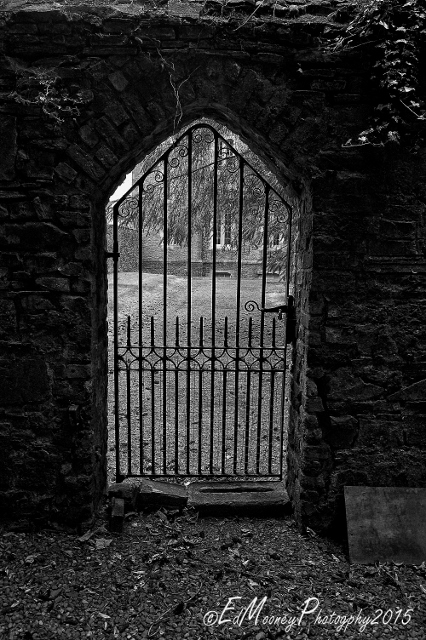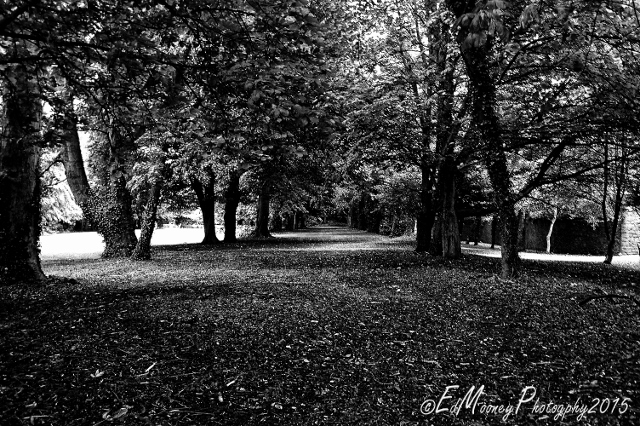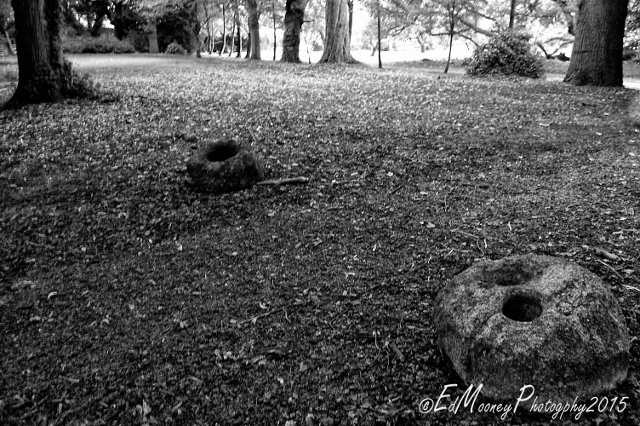Located in the current Dominican Priory of Tallaght, on the grounds of the former Archbishop’s Palace, there is a hidden walled garden. Within this garden there is a beautiful tree lined walkway which runs from North to South, known as the ‘Friar’s Walk’, It was first mentioned during an ordnance survey in 1837. At the north end there was said to be a faint trace of a potential Motte known as the bishops Chair, but like so many antiquities of the area it has sadly been lost in the sands of time. This may very well have been a Motte style fortification built by the Normans in the 12th century where their self-appointed Bishop may have resided. Which is not a far stretch of the imagination considering Tallaght’s strategic significance on the Pale, and its early Christian roots to the nearby monastery of St. Maelruain.
The Friar’s Walk is a slightly raised stretch which runs for approx. 150 meters and is bisected in the middle by another pathway which runs east to west. Despite the vast number of beautiful trees, fauna and various statues which occupy this hidden treasure of a garden, I was after something else. I first heard that there was a Bullán Stone on the grounds of the priory back in 2013 when I spent a number of weeks exploring Tallaght and the surrounding area. Despite numerous visits I was unable to locate this elusive stone and resided to the fact that it either no longer existed, or it was tucked away in the walled garden. And so begun the arduous task of attempting to arrange access to have a look around, despite numerous emails and phone calls I was unable accomplish my goal, and just when I had almost forgotten about it, I received news from the folks at this year’s recent Tallafest. As part of the events for this year there would be a guided walk around the garden by the Nature expert and author Christopher Moriarty. Just goes to show that good things come to those who wait.
At the end of the Nature walk not far from the intersecting path, I struck gold. Not only did I find the elusive Bullán Stone that I had been searching for, but I in fact found two side by side resting under some ancient Yew tree’s. The smaller of the two is most certainly a Bullán Stone and may very well have been used by the early Christian monks from Maelruain’s monastery to grind crops and herbs. The second and larger Stone was said to have been dug out of the Archbishops Bathhouse back in the 19th century. It has been believed at times to have been the base of the ancient Tallaght Cross which once stood during the middle ages in Tallaght Village. Now whilst this may be true, it may not have been its original purpose? The stone itself does have a rather smooth surface which may indicate its prior use as a millstone from a horizontal mill. Looking at the shape of the hole, I reckon this was caused by the shaft of a waterwheel which would have been connected to the grinding stone of a mill in the area, but then again that’s just my humble opinion.
Bullán Stones are quite an interesting subject and can quite easily be ignored as just another ugly stone lying on the ground. I have come across quite a few over the years, most notably at St. Mullins in Carlow, Killgobbin in Dublin and the famous The Deer Stone in Glendalough. With many varied opinions and debates as to the true purpose of these stones ranging from Rock Art to ritual devices. These stones can be traced back through time to the Bronze Age. Whilst the Bullán simply refers to the hemispherical cup hollowed out of a stone, it would seem that they served numerous purposes. Many can be found in and around early Christian sites and could have been used for simply grinding of crops and herbs much like a mortar and pedestal. But many were also known as cursing or healing stones. If you wished to cause harm to someone, it is said that you would roll smaller stones within the Bullán whilst praying or chanting. Rainwater taken from within the Bullán was said to have been a cure for many ailments much alike the many holy wells which were also connected to various saints.
For these and more of my images, why not visit my Website or join me on Facebook or Twitter.









Very interesting, Ed! I have never believed they were ancient mortars and pestle. ..they had far more efficient ways of grinding grain and herbs than that. Having said that, I haven’t come to any conclusions yet, either! 😁
LikeLiked by 1 person
Their is one up in your neck of the woods, Killinagh I think, said to be a cursing stone???
LikeLiked by 1 person
Don’t even know where Killinagh is, Ed! Lol!
LikeLiked by 1 person
LMAO, its just south of Lough MaCnean on the N16 🙂
LikeLiked by 1 person
Omg St Brigid’s Stones! I’m telling you Brigid is popping up everywhere in my life lately!!!
LikeLiked by 1 person
Thats the one 🙂 that girl sure got around in whatever guise you choose to see her.
Bit of a pop star in her day 🙂
LikeLiked by 1 person
Haha! Like that image of her lol!
LikeLike
There seem to have been many Brigids. Up around Ardclough and Oughterard there is mention of a St. Brigid from around the same timeframe, but not the famous Kildare Brigid. Probably a common enough name in its day. I guess looking back it’s easy to see how they might all blend in together…
LikeLiked by 2 people
Ah yes Bríga, daughter of Congall. Commonly mistaken. That church and remains of a round tower in Oughterard is quite special 🙂
LikeLike
Indeed. Le Morte d’Arthur!
LikeLike
Absolutely! I can just imagine all the parents of the time naming their newborn daughters after her, just like parents nowadays name their children after celebrities. 😊
LikeLike
I love these! 😊💖
LikeLiked by 1 person
They are quite interesting arent they 🙂
LikeLike
Yes!
LikeLike
If it’s any help, I think that, if it were Cornwall, the stone would be dismissed fairly quickly as an ordinary millstone.
LikeLike
Most likely John, There are a few similar stones in Kildare which reside around a public house car park. They have a new use, Ash Trays 😦
LikeLike
Who knew Tallaght could be so interesting!? My sister lives there and I have visited from Australia numerous times over the years. Never saw anything old or inviting like this place in the vicinity. Next time I will explore more than the local shopping centre. My sister loves to shop!
LikeLiked by 1 person
Wow, such a small world. I grew up in tallaght, but the shops there are rubbish. Next time your over tell her to try Newbridge or the Outlet at Kildare Village 🙂
Sadly most of Tallaghts interesting places have disappeared over the years, there was at one stage nine castles around the area, only one tower is left as part of the prory.
LikeLike
Love these stones, Ed, and the fact that they are under some yew trees. I am not entirely convinced by the millstone theory, as they seem to occur at so many sacred sites. Pierced stones seem to have a special place in folklore. Great pics and post!
LikeLiked by 1 person
Oh for sure, the air of mystery that surrounds them only adds to their appeal 🙂
LikeLike
Your usual excellent combination of history and images, Ed. They certainly do look like old millstones, at least to me.
Best wishes, Pete.
LikeLiked by 1 person
Thanks Pete 🙂
LikeLike
The first thing that came to mind was the book of the same name!
LikeLiked by 1 person
These stones are really interesting! GREAT post!
★★★★★★★!!!!!!
LikeLiked by 1 person
Thanks a mill Daniel, They are so interesting despite we know so little about them 🙂
LikeLike
That is the beauty of history… stones have ghosts… the ghosts of lost meaning that haunt those of us who will listen if they ever decide to reveal their truth(s).
Have you ever considered that, Ireland being the mystical zone that it is,… you have not chosen the ruins… they have chosen you?
You are their chosen vessel for embodiment?
LikeLiked by 1 person
It sure makes sense, but maybe I might have annoyed them??? My camera is still busted with no sign of a replacement. Perhaps Santa might hook me up 🙂
All joking aside, Ireland is a mystical place, where certain places most certainly have a spirit/energy that can be felt, sometimes I feel like im walking back in time when I visit these places and 9/10 times it is a welcome feeling.
LikeLiked by 1 person
Most interesting! And I love that gate.
LikeLiked by 1 person
It sure is cool, shame they dont open it. Must have lost the key, the lock is rusted to bits. We had to go in via part of the priory buildings 🙂
LikeLiked by 1 person
The American Indians occasionally used a sacred place to grind medicines. I know where one huge stone is in Northern Nevada that has dozens of dimples from this process. They also used mortars and pestles, so there is some difference. They traveled to this site to use this specific stone. It had to be magic, or medicine as they called it.
LikeLiked by 1 person
Im sure this was done amongst many ancient cultures. I think we were pretty much all the same prior to the arrival of the new religions and Empires.
LikeLiked by 1 person
It’s an interesting era that probably deserves more fantasy fiction. I wrote about grinding a stone as a form of blessing once.
LikeLiked by 1 person
Oh really, have you got a link to it?
LikeLiked by 1 person
No. Maybe I should write some one day.
LikeLiked by 1 person
Oh do, I will be the first to read it 🙂
LikeLiked by 1 person
so interesting as always and I love your first image of the peek into the walled garden!!
LikeLiked by 1 person
One of my favorite novels from my youth here Ed…The Secret Garden.
LikeLiked by 1 person
I really want to see this secret place – it’s enchanting and the stones make it even more special.
LikeLiked by 1 person
You should definatly check it out, despite its location the the centre of a busy town it is so peaceful and calm 🙂
LikeLike
The moody pictures are out again, Ed is BACK!
LikeLike
Thank you for liking “Return” and “Vampire Penguin.” Nice work! 🙂 There is so much fascinating history in that secret garden. Ever since I did those posts about rock art on my blog, I have been interested in ancient stones, so I enjoyed learning about the Bullán Stones in this post.
LikeLiked by 1 person